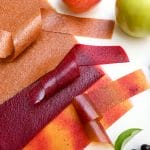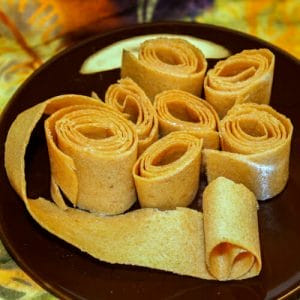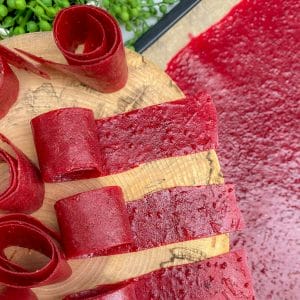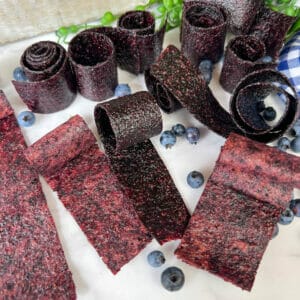How to Make Fruit Leather in a Dehydrator or Oven
Fruit leather or homemade fruit roll ups are a tasty snack that my family loves. It’s basically pureed fruit that’s dried in a thin layer that can be rolled up for perfect sized snacks to go.

The fruit puree can be made from a single fruit or a combination of fruit. It can include flavour makers like lemon juice, cinnamon, herbs, almond extract, etc. It can be made with or without sweeteners. It can even include pieces of chopped fruit, nuts, seeds, coconut flakes, etc.
Read more: Blueberry fruit leather, Cranberry fruit leather, Rhubarb fruit leather or How to Check for Dryness.
This post covers the general steps and frequently asked questions about making fruit leather in a dehydrator or oven. When you’re ready to make a batch, pick a recipe that combines the fruit and flavour combination you love best and go for it! Or, if you’re feeling creative, make your own fruit puree and use these steps to make a delicious treat for you and your peeps.
Video: How to Make Fruit Leather with Frozen Fruit
What fruit is best for Fruit Leather
There are endless fruit options! Choose fruit at it’s peak ripeness for the most delicious leather. Here are the fruits I recommend you try.
- Berries – strawberries, blueberries, raspberries, blackberries
- Stone fruits – apricots, plum, peaches, cherries, chokecherries
- Tropical fruits – mangos, pineapple, papaya
- Others – apples, pears, applesauce, cranberry sauce, pumpkin or squash puree, rhubarb puree
Seeds in fruit like raspberries or blackberries will be noticeable in the final product. If you prefer not to crunch on tiny seeds, push the fruit puree through a fine sieve to remove seeds.
Bananas are high in starch and do not make great fruit leather on their own – but they can add flavour and sweetness when combined with other fruit. Use a small ratio of banana to other fruit.
Fruit with high water content like melons, citrus, kiwi, grapes are best used in combination with other, drier fruits. On their own, the leather will take a LONG time to dry and will become quite thin.
Pro Tip: Fruit naturally high in pectin (apples, plums, citrus, currants, cranberries) will ensure the leather bonds well and makes a nice, crack-free leather. That’s why many recipes often include an apple or applesauce in the recipe.

Should I Use Raw or Cooked Fruit?
Any fresh, canned, cooked or frozen fruit is suitable for making fruit leather. You can use the fruit raw or cooked, whichever you prefer.
Use a single fruit or a combination of fresh, frozen or canned fruit. Create your own combination or follow a tried and true recipe. It all works!
Toppings and Add-ins
Get creative and add a little flare to your fruit leather. Use combinations of different fruit and consider adding some of the following either into the fruit puree or on top of the fruit once it’s spread out on your tray.
Taste the fruit puree before you spread it on the tray and adjust to your liking.
Flavour additions
- spices – like cinnamon, nutmeg, coriander, allspice, clove, ginger, pumpkin pie spice, even hot pepper
- extracts – a little shot of vanilla, lemon, almond or orange extracts or even liqueurs can make a big difference
- juice – lemon, lime, orange, mango, pineapple, lychee
- herbs – finely chopped herbs can add unique flavor, try basil, mint, sage, rosemary, lemon thyme
- chia
- hemp
- nuts
- seeds
- coconut flakes
Pro Tip: Flavour concentrates
Flavour gets concentrated in dried food, so a little goes a long way. For 1 quart/1litre of fruit puree choose:
- pinch to 1/4 tsp spices
- 1/4 to 1/2 tsp extracts or liqueur
- 1 Tbsp juice
- 1/2 – 1 Tbsp fresh, finely chopped/pureed herbs
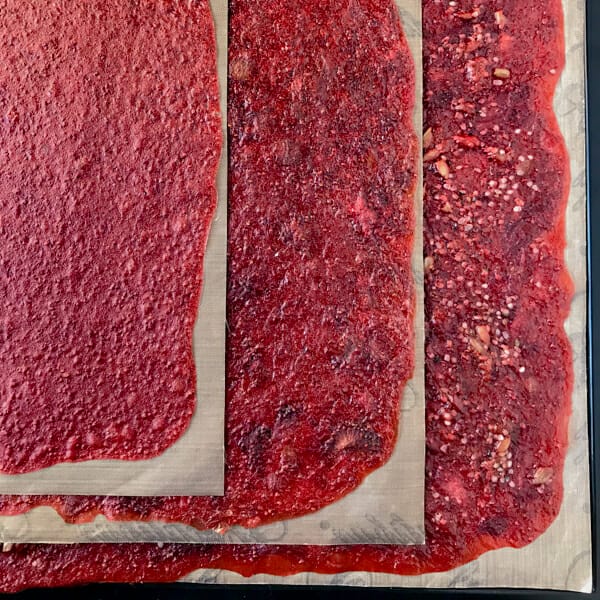
What Sweetener is Best?
You can add as much or as little sweetener as you prefer. In fruit leather, sugar is not needed as a preservative. If your fruit is sweet enough for your liking, you can make it without any sweetener at all. Oh, the beauty of delicious sweet fruit!
You can add sugar, honey, maple or alternative sweeteners, each has it’s pros and cons as shown below. Add according to taste preference. Fruit leathers are shelf stable because moisture has been removed, not because of sugar.
A little will go a long way, use only 1 Tablespoon per quart/litre of fruit puree.
Granulated or Brown Sugar – Be sure to dissolve and distribute well in the fruit puree. Granulated sugar may form tiny crystals if fruit leather is stored for 3 months or more (likely not an issue!)
Honey, Maple Syrup, Corn Syrup, Brown Rice Syrup or Other Liquid Sweeteners – Liquid sweeteners will add some stickiness to the finished product so it’s important not to over do it!. When checking if your fruit leather is done, remember that some of the tackiness is from the sweetener, so double check all the other criteria to know if your fruit leather is ready.
Other Powdered Sweeteners – Choose your favourite sweetener like (stevia, erythritol, xylitol, monk fruit powder, etc) and dissolve it into the fruit puree. Taste and adjust as needed. Note: I have never tried using any of these, but as long as it dissolves in the fruit puree, there shouldn’t be an issue).
Other Fruit – This is my favourite way to sweeten fruit leather that is a little tart (cranberry or rhubarb), I simply add other fruit that is sweeter and complements the main fruit. Rhubarb and strawberry is one of my favourite combinations!
How to Dry Fruit Leather in a Dehydrator
Dry Fruit Leather in a Dehydrator
Equipment
- dehydrator
Ingredients
- 2-3 cups fruit purée* per tray
Instructions
- Line dehydrator with paraflexx sheet, parchment paper, silpat or plastic wrap. NEVER use wax paper!
- Spread fruit puree on a lined dehydrator tray about ⅛ to ¼ inch (2-5 mm) thick. Use an offset spatula to ensure a nice even layer. I like forming the puree into a nice square or rectangle so I get even rolls when it comes time to cutting the sheets.
- Place in dehydrator and dry at 135°F (57°C) for 6-8 hours (even longer in humid conditions).
- At the 6 hour mark, check for dryness. Press leather with flat fingers, if there’s an indentation or any dark, wet spots, it’s not ready. If it comes off easily, it is done. Watch how to tell if Fruit Leather is Dry.
- Let cool completely then roll and cut into strips.
Video
Notes

How to Dry Fruit Leather in an Oven
Here are the steps for making fruit leather in the oven once you have your fruit puree prepared.
It takes about 3-4 cups of fruit puree for an 11×17 inch baking sheet.
- Prepare the puree as outlined your favourite recipe.
- Preheat the oven to 170°F (80°C). Line a rimmed baking sheet with parchment paper or silicone mat.
- Spread the puree on the parchment paper about 1/8to 1/4 inch (2-5 mm) thin. An offset spatula really helps with this.
- Bake for 6 to 8 hours, or until no longer sticky to the touch, no wet spots are visible, does not leave any indentations when pressed with fingers and separates easily from parchment paper.
- Remove from oven and let cool completely.
- Either remove from parchment paper or roll with the parchment paper (prevents the roll from sticking to itself).
- Use kitchen scissors or a sharp knife to cut into rolls. Enjoy.
Pro Tip: NEVER use wax paper when dehydrating – in the oven or in the dehydrator. It will stick horribly! Use parchment paper.
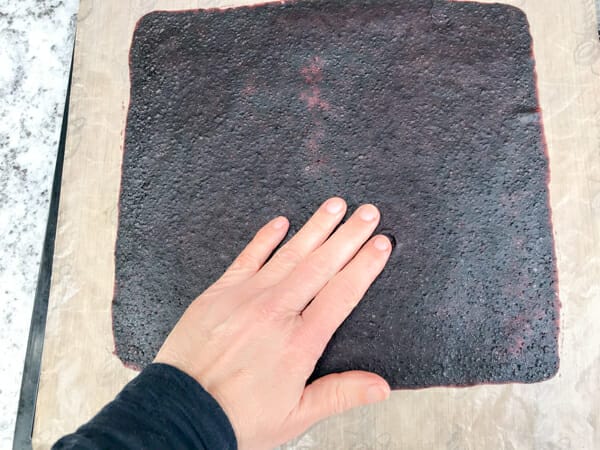
How to Check for Dryness
Look and feel for dryness. And remember, it’s better to over-dry than under-dry. Still curious? Read more here for detailed description of How to Check for Dryness of Fruit Leather. That said, if it gets brittle, here’s What to do if My Fruit Leather is Too Dry. Or watch these videos below for some quick tips.
Videos: Check for Dryness

What if My Leather Becomes Dry and Brittle?
Sometimes, fruit leather can become so dry it gets brittle. This doesn’t mean it’s gone bad, it’s just that more moisture has evaporated. Here are some ideas what to do with dry, brittle fruit leather:
- Rehydrate it – Place a damp towel next to (not touching) the fruit leather. The leather will reabsorb some of the moisture.
- Powder it – Turn the brittle leather into a powder by placing in a spice grinder and grinding it into a powder. This powder can be used in desserts, in yogurt, in smoothies, on top of ice cream, in pancake mix, etc.
- Sauce it – Break leather into small pieces and cover with boiling water, soak for 10-15 minutes. Use about 1/2 cup water for 1 cup leather bits. Eat as is or spoon over yogurt, ice cream or pancakes.
Videos: What to do with Dry Leather
How To Store Fruit Leather
Fruit leather easily re-absorbs moisture, so it’s important to store it in an airtight, dry container.
I roll my leather and cut into small, single serve pieces. I store these in an airtight container that’s kept in the kitchen cupboard. If your house is very warm or humid, keep fruit leather in the fridge to prevent it from absorbing moisture or becoming overly sticky.
You can also store fruit leather in the freezer.
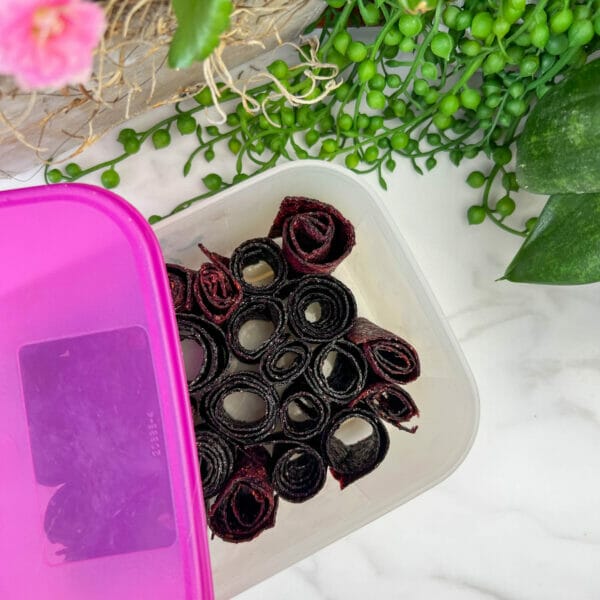
How Long Does Fruit Leather Last?
Fruit leather is shelf stable because the drying process removes water that can lead to spoilage. When properly dried and stored in a dry, air tight environment, fruit leather will last for months. But your peeps will gobble it up long before then! Remember, when exposed to air or humidity, it will continue to dry out or reabsorb moisture, so always seal tightly.
If your leather includes nuts or seeds, the shelf life will be much shorter. To prevent nuts and seeds from going rancid, store for up to 3 weeks at room temperature or freeze for longer storage.
Fruit Roll Up Recipes
Are you ready to make some homemade fruit rollups? What fruit and flavour combinations will you use? Let me know how it goes, leave a comment below or tag #getgettys on Instagram when you post a photo.



